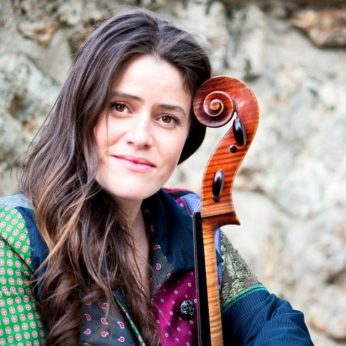Composer: Johann Sebastian Bach (b. 1685 - d. 1750)
Performance date: 04/07/2019
Venue: St. Brendan’s Church
Duration: 00:21:12
Recording Engineer: Gar Duffy, RTÉ
Instrumentation: vc
Instrumentation Category:Solo
Artists:
Emmanuelle Bertrand -
[cello]

Cello Suite No 2 in D minor BWV 1008
Prélude
Allemande
Courante
Sarabande
Menuet I & II
Gigue
In the commonest types of dances, one finds, along with the familiar and the obvious, something that is new, lively, impressive, and expressive. In the noblest types of dances, one finds the melodious expression of majesty and magnificence; indeed, even in the smallest minuet there is no lack of beauty and grace.-
Johann Mattheson
Bach’s Cello Suites alongside his Sonatas and Partitas for Solo Violin constitute one of the most significant collections of early works for unaccompanied string instruments. We have almost no direct information about the composition of the Suites, there are two copies from Bach’s lifetime, Anna Magdalena’s from 1728 and Johann Kellner’s from 1726. In addition there is the autograph manuscript of the Lute Sonata, a transcription in Bach’s hand of the Fifth Suite. Bach’s five years (1717-1723) as Kapellmeister at Köthen was the only time in his life when he had a virtuoso chamber ensemble and no choir to direct, thus the flurry of instrumental works. There are two significant dates during his residency – in July 1720 his first wife Maria Barbara dies unexpectedly and in December 1721 he married Anna Magdalena. Many commentators see Maria Barbara’s death reflected in his solo works.
The key of D minor is often described as one of despair and melancholy. The devastating Chaconne from Bach’s D minor Partita is thought by some to manifest his musical reaction to the sudden death of Maria Barbara. By analogy the D minor Cello Suite may reflect some of these emotions – it is certainly a dark and sombre work, similar to the Fifth Suite the other minor key work in the series. The Prélude opens hesitantly as if feeling its way in the darkness, but gradually opens up to let in flashes of light. The Allemande is a movement of great deliberation and intensity. Forkel wrote that Bach’s melodies were often uncommon, strange, and entirely new, hitherto unheard-of turns, and the melody of this Allemande could well be considered uncommon and strange.
The ‘running’ nature of the Italian style Courante is most obvious in this Suite because it consists almost entirely of sixteenth notes which give the movement a perpetual sense of forward motion. The Sarabande of the Second Suite is possibly the most expressive and well-known one from all the Cello Suites. The music moves in a predominantly stepwise fashion within a small range allowing the performer to explore the darkness. The first Menuet brings to mind the second Menuet of the First Suite. It is in a minor key and based on a chaconne bass but unlike the First Suite, makes great use of double and triple stops. Its partnering dance is a simple delightful piece, proving that music does not have to be complex in order to be effective. The Gigue is in a typical Bach French/Italian hybrid style and almost bipolar in emotion. The first characteristic we meet is of a chipper and gay disposition which starkly contrasts with the persistent anguished emotion of the latter half of the piece.
– Norah O’Leary
Copyright © 2025 West Cork Music. All rights reserved.
Designed and developed by Matrix Internet